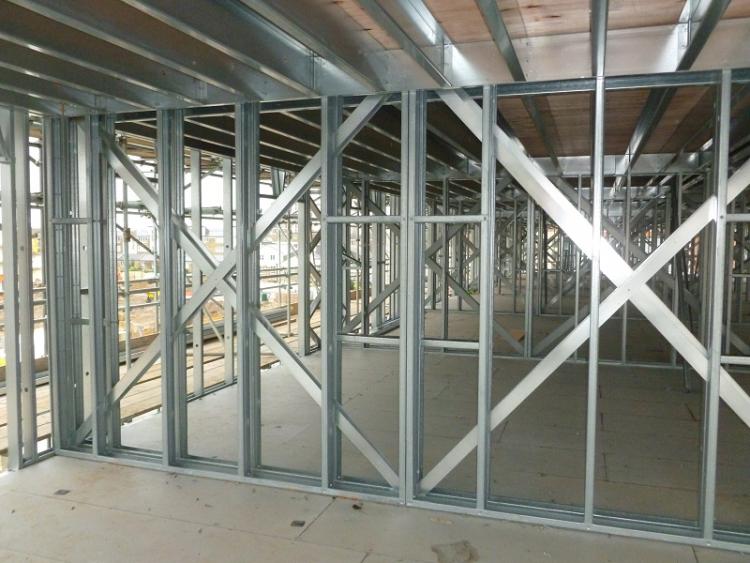
Mark Lawson consultant to The Steel Construction Institute (SCI) writes about the stability of light steel framing and their work on the diaphragm action of boards.
Sheathing boards of various types are widely used in timber framing and light steel framing. In timber framing wood-based boards such as OSB/3 are used to provide diaphragm action and shear resistance to stabilise the structure, but this is not currently the case in light steel framing (LSF). In LSF the global stability of the structure is typically provided by X and K bracing that are built into the wall panels as part of the manufacturing process.
The forthcoming SCI publication P437 will provide guidance on stability systems in LSF using conventional bracing systems to Eurocodes and importantly it permits the use of various types of sheathing board such as cement particle board, cement fibre boards and calcium silicate boards to deliver diaphragm action, provided this is supported by test data on wall panels. Wood-based boards such as OSB3 may also be used subject to constraints of fire resistance to the new Part B of the Building Regulations.
The proposed method of test of 2.4m square wall panels is the same as in BS EN 594: Timber Structures – Test Methods – Racking Strength of Timber Wall Panels. A typical test is shown in Figure 2 with an applied vertical load of 5 kN per stud to represent the minimum load that would be used in practice in medium-rise buildings. To avoid risk of the ratcheting effect of repeated loading on the screws to the boards, the limiting deflection used to determine the shear stiffness of the panel is taken as panel height/500 and this same displacement is used in determining the shear force that may be resisted at serviceability loading. This is compatible with the shear deflection of braced light steel walls and so in principle, the use of boarded and braced panels may be combined in one structure based on their relative stiffness.
In addition, SCI-P437 will propose the use of small-scale push tests to supplement the larger wall panel tests, which allows for more parametric testing of different types of boards, steel thicknesses, diameter of screws, edge distances of screws etc. A typical push test using 200 x 200 mm square boards with four screws per side, is shown in Figure 3.
SCI proposes that the test protocol for these push tests should involve 10 cycles of load to 40% of the failure load of the first test in order to observe if there is any loss of stiffness under repeated load to serviceability load levels. This implies that the failure load of a particular test should exceed 2.5 x design resistance at the serviceability limit state (SLS).
A design method has been developed to determine the shear stiffness of any geometry of wall panel based on test results, the stiffness of the screws and the elastic modulus of the board. This allows the shear stiffness of any size of wall panel and fixing spacing to be determined and correlated with a standard wall test to be able to extend the wall test to other geometries within the limits of the materials and screw type tested.
Typical values of the screw shear stiffness range from 1.0 kN/mm for OSB/3 board to 1.3 kN/m for a calcium silicate board, and 0.5 kN/mm for Type F plasterboards. Currently the use of plasterboard is not accepted for diaphragm action unlike in the USA where it is widely used, albeit with relatively low shear resistance.
The allowable shear loads that may be resisted at the SLS are expressed in kN/m length of the wall and are typically in the range of 2 to 3 kN/m for most suitable sheathing boards. These resistances may be increased by a partial factor of x 1.5 for loading at the ultimate limit state, although the design criterion is based on the SLS.
Other factors that should be taken into consideration when evaluating diaphragm action, are the long-term durability of the boards and their fixings, potential for damage and replacement (i.e. due to flooding) and the effect of large openings, partially in façade panels.
For more information on the forthcoming SCI publication P437 and on SCI's work with the Light Steel Forum, contact Andrew Way at SCI: www.steel-sci.com
Stay in touch: